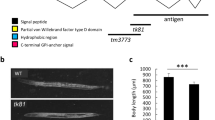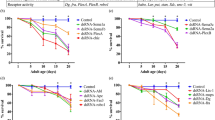Abstract
In nervous systems with bilateral symmetry, many neurons project axons across the midline to the opposite side. In each segment of the Drosophila embryonic nervous system, axons that display this projection pattern choose one of two distinct tracts: the anterior or posterior commissure. Commissure choice is controlled by Derailed, an atypical receptor tyrosine kinase expressed on axons projecting in the anterior commissure. Here we show that Derailed keeps these axons out of the posterior commissure by acting as a receptor for Wnt5, a member of the Wnt family of secreted signalling molecules. Our results reveal an unexpected role in axon guidance for a Wnt family member, and show that the Derailed receptor is an essential component of Wnt signalling in these guidance events.
This is a preview of subscription content, access via your institution
Access options
Subscribe to this journal
Receive 51 print issues and online access
$199.00 per year
only $3.90 per issue
Buy this article
- Purchase on Springer Link
- Instant access to full article PDF
Prices may be subject to local taxes which are calculated during checkout





Similar content being viewed by others
References
Dickson, B. J. Molecular mechanisms of axon guidance. Science 298, 1959–1964 (2002)
Kennedy, T. E., Serafini, T., de la Torre, J. R. & Tessier-Lavigne, M. Netrins are diffusible chemotropic factors for commissural axons in the embryonic spinal cord. Cell 78, 425–435 (1994)
Harris, R., Sabatelli, L. M. & Seeger, M. A. Guidance cues at the Drosophila CNS midline: identification and characterization of two Drosophila Netrin/UNC-6 homologs. Neuron 17, 217–228 (1996)
Mitchell, K. J. et al. Genetic analysis of Netrin genes in Drosophila: Netrins guide CNS commissural axons and peripheral motor axons. Neuron 17, 203–215 (1996)
Seeger, M., Tear, G., Ferres, M. D. & Goodman, C. S. Mutations affecting growth cone guidance in Drosophila: genes necessary for guidance toward or away from the midline. Neuron 10, 409–426 (1993)
Kidd, T., Russell, C., Goodman, C. S. & Tear, G. Dosage-sensitive and complementary functions of roundabout and commissureless control axon crossing of the CNS midline. Neuron 20, 25–33 (1998)
Kidd, T. et al. Roundabout controls axon crossing of the CNS midline and defines a novel subfamily of evolutionarily conserved guidance receptors. Cell 92, 205–215 (1998)
Kidd, T., Bland, K. S. & Goodman, C. S. Slit is the midline repellent for the robo receptor in Drosophila. Cell 96, 785–794 (1999)
Rajagopalan, S., Nicolas, E., Vivancos, V., Berger, J. & Dickson, B. J. Crossing the midline: roles and regulation of Robo receptors. Neuron 28, 767–777 (2000)
Simpson, J. H., Kidd, T., Bland, K. S. & Goodman, C. S. Short-range and long-range guidance by slit and its Robo receptors. Robo and Robo2 play distinct roles in midline guidance. Neuron 28, 753–766 (2000)
Keleman, K. et al. Comm sorts robo to control axon guidance at the Drosophila midline. Cell 110, 415–427 (2002)
Bonkowsky, J. L., Yoshikawa, S., O'Keefe, D. D., Scully, A. L. & Thomas, J. B. Axon routing across the midline controlled by the Drosophila Derailed receptor. Nature 402, 540–544 (1999)
Callahan, C. A., Muralidhar, M. G., Lundgren, S. E., Scully, A. L. & Thomas, J. B. Control of neuronal pathway selection by a Drosophila receptor protein-tyrosine kinase family member. Nature 376, 171–174 (1995)
Moreau-Fauvarque, C., Taillebourg, E., Preat, T. & Dura, J. M. Mutation of linotte causes behavioral defects independently of pigeon in Drosophila. Neuroreport 13, 2309–2312 (2002)
Hovens, C. M. et al. RYK, a receptor tyrosine kinase-related molecule with unusual kinase domain motifs. Proc. Natl Acad. Sci. USA 89, 11818–11822 (1992)
Oates, A. C. et al. Embryonic expression and activity of doughnut, a second RYK homolog in Drosophila. Mech. Dev. 78, 165–169 (1998)
Halford, M. M., Oates, A. C., Hibbs, M. L., Wilks, A. F. & Stacker, S. A. Genomic structure and expression of the mouse growth factor receptor related to tyrosine kinases (Ryk). J. Biol. Chem. 274, 7379–7390 (1999)
Katso, R. M., Russell, R. B. & Ganesan, T. S. Functional analysis of H-Ryk, an atypical member of the receptor tyrosine kinase family. Mol. Cell Biol. 19, 6427–6440 (1999)
Savant-Bhonsale, S., Friese, M., McCoon, P. & Montell, D. J. A Drosophila derailed homolog, Doughnut, expressed in invaginating cells during embryogenesis. Gene 231, 155–161 (1999)
Yoshikawa, S., Bonkowsky, J. L., Kokel, M., Shyn, S. & Thomas, J. B. The derailed guidance receptor does not require kinase activity in vivo. J. Neurosci. 21, RC119 (2001)
Halford, M. M. et al. Ryk-deficient mice exhibit craniofacial defects associated with perturbed Eph receptor crosstalk. Nature Genet. 25, 414–418 (2000)
Patthy, L. The WIF module. Trends Biochem. Sci. 25, 12–13 (2000)
Hsieh, J. C. et al. A new secreted protein that binds to Wnt proteins and inhibits their activities. Nature 398, 431–436 (1999)
Wodarz, A. & Nusse, R. Mechanisms of Wnt signaling in development. Annu. Rev. Cell Dev. Biol. 14, 59–88 (1998)
Hall, A. C., Lucas, F. R. & Salinas, P. C. Axonal remodeling and synaptic differentiation in the cerebellum is regulated by WNT-7a signaling. Cell 100, 525–535 (2000)
Krylova, O. et al. WNT-3, expressed by motoneurons, regulates terminal arborization of neurotrophin-3-responsive spinal sensory neurons. Neuron 35, 1043–1056 (2002)
Packard, M. et al. The Drosophila Wnt, wingless, provides an essential signal for pre- and postsynaptic differentiation. Cell 111, 319–330 (2002)
Bhanot, P. et al. A new member of the frizzled family from Drosophila functions as a Wingless receptor. Nature 382, 225–230 (1996)
Vinson, C. R. & Adler, P. N. Directional non-cell autonomy and the transmission of polarity information by the frizzled gene of Drosophila. Nature 329, 549–551 (1987)
Fradkin, L. G., Noordermeer, J. N. & Nusse, R. The Drosophila Wnt protein DWnt-3 is a secreted glycoprotein localized on the axon tracts of the embryonic CNS. Dev. Biol. 168, 202–213 (1995)
Eisenberg, L. M., Ingham, P. W. & Brown, A. M. Cloning and characterization of a novel Drosophila Wnt gene, Dwnt-5, a putative downstream target of the homeobox gene distal-less. Dev. Biol. 154, 73–83 (1992)
Russell, J., Gennissen, A. & Nusse, R. Isolation and expression of two novel Wnt/wingless gene homologues in Drosophila. Development 115, 475–485 (1992)
Brand, A. H. & Perrimon, N. Targeted gene expression as a means of altering cell fates and generating dominant phenotypes. Development 118, 401–415 (1993)
Dittrich, R., Bossing, T., Gould, A. P., Technau, G. M. & Urban, J. The differentiation of the serotonergic neurons in the Drosophila ventral nerve cord depends on the combined function of the zinc finger proteins Eagle and Huckebein. Development 124, 2515–2525 (1997)
Callahan, C. A. & Thomas, J. B. Tau-β-galactosidase, an axon-targeted fusion protein. Proc. Natl Acad. Sci. USA 91, 5972–5976 (1994)
Rajagopalan, S., Vivancos, V., Nicolas, E. & Dickson, B. J. Selecting a longitudinal pathway: Robo receptors specify the lateral position of axons in the Drosophila CNS. Cell 103, 1033–1045 (2000)
Golembo, M., Raz, E. & Shilo, B. Z. The Drosophila embryonic midline is the site of Spitz processing, and induces activation of the EGF receptor in the ventral ectoderm. Development 122, 3363–3370 (1996)
Wehrli, M. et al. arrow encodes an LDL-receptor-related protein essential for Wingless signalling. Nature 407, 527–530 (2000)
Tamai, K. et al. LDL-receptor-related proteins in Wnt signal transduction. Nature 407, 530–535 (2000)
Bhat, K. M. frizzled and frizzled 2 play a partially redundant role in wingless signaling and have similar requirements to wingless in neurogenesis. Cell 95, 1027–1036 (1998)
Bhanot, P. et al. Frizzled and Dfrizzled-2 function as redundant receptors for Wingless during Drosophila embryonic development. Development 126, 4175–4186 (1999)
Chen, C. M. & Struhl, G. Wingless transduction by the Frizzled and Frizzled2 proteins of Drosophila. Development 126, 5441–5452 (1999)
Cadigan, K. M., Fish, M. P., Rulifson, E. J. & Nusse, R. Wingless repression of Drosophila frizzled 2 expression shapes the Wingless morphogen gradient in the wing. Cell 93, 767–777 (1998)
Yamaguchi, T. P., Bradley, A., McMahon, A. P. & Jones, S. A Wnt5a pathway underlies outgrowth of multiple structures in the vertebrate embryo. Development 126, 1211–1223 (1999)
Mata, J., Curado, S., Ephrussi, A. & Rorth, P. Tribbles coordinates mitosis and morphogenesis in Drosophila by regulating string/CDC25 proteolysis. Cell 101, 511–522 (2000)
Cohen, E. D. et al. DWnt4 regulates cell movement and focal adhesion kinase during Drosophila ovarian morphogenesis. Dev. Cell 2, 437–448 (2002)
Callahan, C. A., Yoshikawa, S. & Thomas, J. B. Tracing axons. Curr. Biol. 8, 582–586 (1998)
Gieseler, K. et al. Antagonist activity of DWnt-4 and wingless in the Drosophila embryonic ventral ectoderm and in heterologous Xenopus assays. Mech. Dev. 85, 123–131 (1999)
Noordermeer, J., Johnston, P., Rijsewijk, F., Nusse, R. & Lawrence, P. A. The consequences of ubiquitous expression of the wingless gene in the Drosophila embryo. Development 116, 711–719 (1992)
Thor, S. & Thomas, J. B. The Drosophila islet gene governs axon pathfinding and neurotransmitter identity. Neuron 18, 397–409 (1997)
Acknowledgements
We thank G. Struhl, R. Nusse, E. Wilder, B. Dickson and the Bloomington Stock Center for stocks; L. Fradkin and J. Noordermeer for the Wnt5 antibody, stocks and for sharing results prior to publication; and G. Lemke, L. Santschi and M. Boyle for discussion and critical reading of the manuscript. This work was supported by an NRSA fellowship to M.K. and grants from the NIH to R.D.M. and J.B.T. R.D.M. is a member of the Cancer Institute of New Jersey.
Author information
Authors and Affiliations
Corresponding author
Ethics declarations
Competing interests
The authors declare that they have no competing financial interests.
Rights and permissions
About this article
Cite this article
Yoshikawa, S., McKinnon, R., Kokel, M. et al. Wnt-mediated axon guidance via the Drosophila Derailed receptor. Nature 422, 583–588 (2003). https://doi.org/10.1038/nature01522
Received:
Accepted:
Published:
Issue Date:
DOI: https://doi.org/10.1038/nature01522
This article is cited by
-
Systematic review of the receptor tyrosine kinase superfamily in neuroblastoma pathophysiology
Cancer and Metastasis Reviews (2022)
-
FOXG1 Directly Suppresses Wnt5a During the Development of the Hippocampus
Neuroscience Bulletin (2021)
-
Receptor tyrosine kinase profiling of ischemic heart identifies ROR1 as a potential therapeutic target
BMC Cardiovascular Disorders (2018)
-
The Wnt receptor Ryk is a negative regulator of mammalian dendrite morphogenesis
Scientific Reports (2017)
-
An embryonic system to assess direct and indirect Wnt transcriptional targets
Scientific Reports (2017)
Comments
By submitting a comment you agree to abide by our Terms and Community Guidelines. If you find something abusive or that does not comply with our terms or guidelines please flag it as inappropriate.



